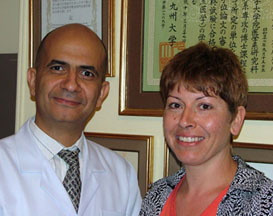Multifocal Intraocular Lenses
The introduction of multifocal intraocular lenses (trifocal, extended depth of focus intraocular lenses)

The use of multifocal and trifocal intraocular lenses when undergoing cataract surgery can, in suitable cases, alleviate the need to use glasses for far or near after the cataract operation.
Traditionally, when a cataract develops (cloudy lens), or when a decision is taken to replace the naturally occuring lens by an artificial lens for refractive purposes to correct high short-sightedness or long-sightedness (refractive lens exchange; RLE), the human lens is commony replaced with an artificial intraocular lens (IOL) inside the eye. This lens is usually focused for distance vision and the patient needs to wear reading glasses for all near tasks because of lack of accommodation or the ability of the lens to focus at near.
The use of multifocal and trifocal intraocular lenses can eliminate the need for glasses following cataract surgery
Through recent advancements in lens technology, we now have several options of multifocal intraocular lenses available that can provide a range of vision (near through distance) enabling a high degree of freedom from spectacles. Multifocal and trifocal intraocular lenses provide excellent vision after cataract surgery at a variety of distances eliminating the need for reading-bi-multifocal glasses afterwards.
Eye ability to see at near (accommodation) and presbyopia are naturally reduced after the age of 40

The newly introduced multifocal and trifocal intraocular lenses are becoming increasingly popular. They can provide a full range of functional vision for patients who have a strong desire to significantly decrease their dependence on glasses and contacts. So, patients implanted with multifocal and trifocal intraocular lenses will likely find that they can drive, watch television, read or do crafts-without the need for glasses
Multifocal and trifocal intraocular lenses are a breakthrough in cataract surgery

Multifocal and trifocal intraocular lenses are a breakthrough . They can afford cataract patients restoration of vision at all focal lengths from near through distance.
For most cataract patients, life without reading glasses or bifocals is something they either experienced before presbyopia or they just dreamed about the most of their lives. But today, the multifocal and trifocal intraocular lenses are turning those dreams into reality with its revolutionary lens technology, which is designed to allow patients to see clearly at all distances without bifocals or reading glasses.
Dr Ahmad Khalil is a leader in implantation of the multifocal and trifocal intraocular lenses and was among the first cataract surgeons in Cairo to implant the ReSTOR lens.
Multifocal and trifocal intraocular lenses are implanted through a tiny incision, and unfolds inside the eye to take its planned location
- The ability to read and perform other tasks without glasses varies from person to person but is generally best when multifocal and trifocal intraocular lenses are placed in both eyes.
- It usually takes 6 to 12 weeks after surgery on the second eye for the brain to adapt and vision improvement to be complete with either of these IOL types.
- Each person’s success with multifocal and trifocal intraocular lenses may depend on the size of his/her pupils and other eye health factors. People with astigmatism can ask Dr Khalil about toric IOLs and related treatments
- Side effects such as glare or halos around lights, or decreased sharpness of vision (contrast sensitivity) may occur, especially at night or in dim light. Most people adapt to and are not bothered by these effects, but those who frequently drive at night or need to focus on close-up work may be more satisfied with monofocal IOLs
|
% Totally free of spectacles |
% Severe glare |
% Severe halos |
% Who would have the same lens implanted again |
|
|
Monofocal IOL |
10 |
Severe: up to 0.7% Moderate: up to 5% |
Severe: Rarely Moderate: up to 2.5% |
Not asked |
|
mIOL |
75 – 85 |
0 – 8.5 |
4 |
95 |
| Chiam PJT et al. Journal of Cataract and Refractive Surgery 2006; 32: 1459-1463 Wolffe M et al. Eye 2006 Aug 25 [Epub] | ||||
Messages from patients of Dr Khalil Eye Clinic
Messages from some of Dr Khalil Eye Clinic friends, who had their eye operations done by Dr Ahmad Khalil






















